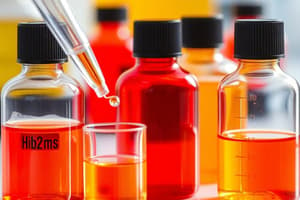Podcast
Questions and Answers
What are the two main components of a solution?
What are the two main components of a solution?
- Solute and solvent (correct)
- Acid and base
- Electrons and protons
- Ionic and covalent bonds
What is solvation?
What is solvation?
- The equilibrium established between the undissolved and dissolved fractions of solute
- The interaction of a solute with the solvent leading to the stabilization of the solute within the solution (correct)
- The amount of solute that can be dissolved
- The transfer of ions or molecules from the solute into solution
What is solubility?
What is solubility?
- The equilibrium established between the undissolved and dissolved fractions of solute
- The transfer of ions or molecules from the solute into solution
- The amount of solute that can be dissolved (correct)
- The interaction of a solute with the solvent leading to the stabilization of the solute within the solution
What is dissolution?
What is dissolution?
What is the maximum mass or volume of solute that will dissolve in a given mass or volume of solvent at a set temperature?
What is the maximum mass or volume of solute that will dissolve in a given mass or volume of solvent at a set temperature?
What is a saturated solution?
What is a saturated solution?
What affects the solubility of a compound?
What affects the solubility of a compound?
What are the two main components of a solution?
What are the two main components of a solution?
What is solvation?
What is solvation?
What is solubility?
What is solubility?
What is dissolution?
What is dissolution?
What is the maximum mass or volume of solute that will dissolve in a given mass or volume of solvent at a set temperature?
What is the maximum mass or volume of solute that will dissolve in a given mass or volume of solvent at a set temperature?
What is a saturated solution?
What is a saturated solution?
What affects the solubility of a compound?
What affects the solubility of a compound?
Flashcards are hidden until you start studying
Study Notes
Understanding Solutions, Solvation, Solubility, and Dissolution
- A solution consists of two main components: solvent and solute.
- Dissolution is the transfer of ions or molecules from the solute into solution and is controlled by the molecular affinity between solute and solvent.
- Solvation is the interaction of a solute with the solvent, leading to the stabilization of the solute within the solution.
- Solubility is the amount of solute that can be dissolved, and it is affected by various factors such as temperature, pH, molecular structure, and particle size of the solute.
- The solubility of a compound is the amount that passes into solution when equilibrium is established between the dissolved solute and the excess solute.
- A saturated solution is produced once an equilibrium is established between the undissolved and dissolved fractions of solute.
- Like dissolves like, so polar solutes dissolve in polar solvents, and non-polar solutes dissolve in non-polar solvents.
- The dissolution process involves interfacial reaction and diffusion through the boundary layers, which is determined by Fick's Law of Diffusion.
- The rate of dissolution is determined by the rate of diffusion through the boundary layers.
- A larger surface area and increasing temperature often increase solubility and dissolution rate.
- Solutions have advantages such as uniformity of concentration and ease of manufacture but also have disadvantages such as instability of compounds in solution and poor solubility.
- Solubility is expressed in concentration by the maximum mass or volume of solute that will dissolve in a given mass or volume of solvent, at a set temperature.
Studying That Suits You
Use AI to generate personalized quizzes and flashcards to suit your learning preferences.




